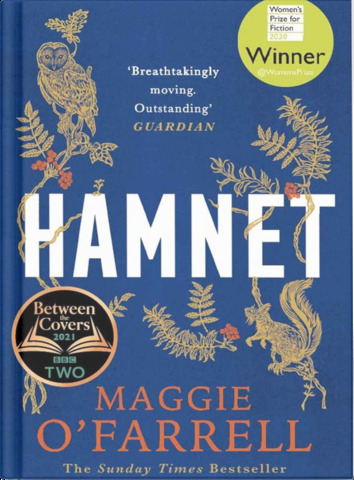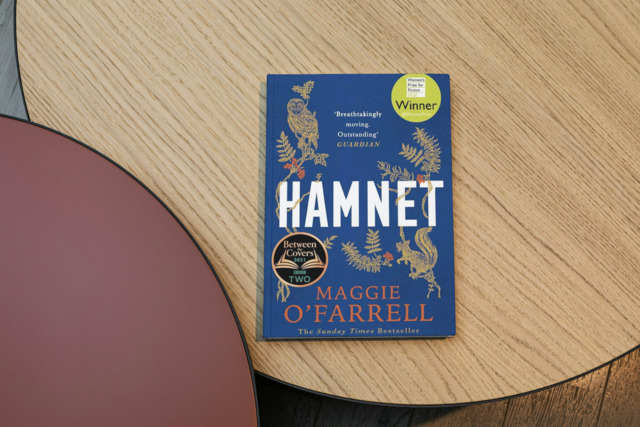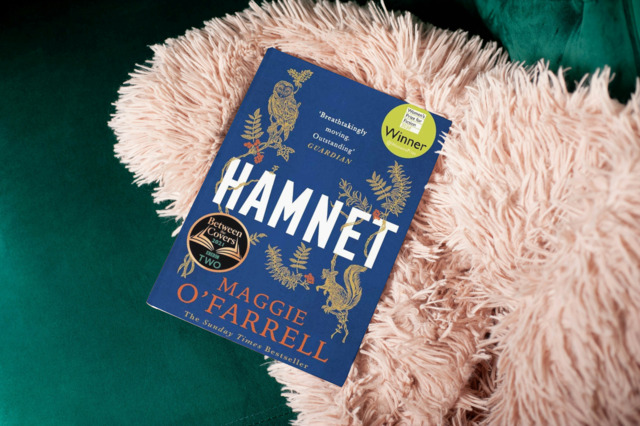Historical fiction is a well-loved genre of books, as we stop and look back on times and lives gone by and try to understand people who may be removed from us in time, but not so much in how life progresses.
Hamnet and Hamlet were the same name in the late sixteenth and early seventeenth century, and it is believed that Shakespeare wrote the play Hamlet, four years after his son Hamnet died at the age of eleven. Author Maggie O’Farrell has taken a very well-known name here and built the lives of his family focusing on the period of 1583 – 1596 to give us a book titled Hamnet.
| Book Title | : | Hamnet A Novel of the Plague |
| Author | : | Maggie O'Farrell |
| Published by | : | Vintage Books ( 2021) |
| # of Pages | : | 305 (Paperback) 321; 3482KB (Kindle EBook) 631 Minutes (Audiobook) |
| Purchase Link(s) | : |
Like a lot of other readers, we also like historical fiction and so this critically acclaimed book was very appealing. And here are our views on this book on behalf of Team Thinkerviews.
This Is Here In For You
Book Cover:
Let us take a look at the cover page of this book.

Hamnet by Maggie O’Farrell | Book Cover
The cover page of this book has a vintage look and feel. The colour scheme features blue background with the book title in white, filigree of creatures and elements in light yellow and blossom in orange including the author’s name. The coverpage also showcases the prizes and acclaims this book has gained, marking it’s popularity with the readers..
Overall, I found the cover page will attract browsers and fans of the author looking for an entertaining read…
Storyline:
An eleven year old boy is coming down the stairs, looking for the adults in his life. His twin sister is not feeling well, and so Hamnet looks around for his mother Agnes, his elder sister Susanna, his grandmother Mary, but instead finds his ill-tempered grandfather John, and ends up receiving a blow to the face. He runs to the physician, but the doctor is away, and so he comes back to his twin sister Judith, feeling helpless.
In the background, we meet their parents. Agnes, who has grown without a mother, feeling the ill-treatment of her stepmother, with stories about her lost mother being a child of the forest. As a grown woman, she has a reputation herself of being able to make predictions, being fond of the forest and the beasts, growing herbs too provide medicines, and taming bees to produce honey. She keeps a falcon, and this is how the father first sees her – coming out of the forest with a hooded kestrel on her arm.

Hamnet by Maggie O’Farrell | Book Cover
He is younger than her, the Latin tutor who comes to her house to teach her younger stepbrothers. The pair are drawn to each other and in spite of family protests, manage to get married once Agnes is carrying their first child. They make their home in a small apartment next to the family home. But the father is restless. He struggles to find his trade in the small town of Stratford, and by the time the twins are on the way, Agnes can see how he will need to go to London.
They are hoping for the family to live together in London, as soon as they can. But when the twins are born, that changes. While the boy is healthy, the girl is fragile. And as she grows, it becomes harder for the parents to see how she could survive in London. And so a long period of separation begins. And now, the twins are eleven years old, and a severe illness is on their doorstep.
As the day progresses, the household returns, but it is some time before Agnes is back and looking for the twins. And then the women of the household come together, devoting themselves to the care of the girl, who has caught the much-feared, nearly uncurbable plague. But as the twins have tried to take each other’s place to pull tricks on the world around them all their lives, Hamnet decides to do it once more, take his sister’s place in eyes of the death….
And what will this do to the family, the grieving parents, remaining children, and how will this tragedy translate to one of the best-known plays in the world?
Views and Reviews:
Author Maggie O’Farrell’s writing is what makes this book an emotional and evocative read. She writes with a flair for the language and storytelling that shines throughout the book. Although, from the name of the book, it might appear to be a tale of the child named Hamnet, or his famous father Shakespeare who looms large with his play in the background, it is a story of a lot more.
It is a story of a family, of strangers coming together to form the closest of bonds and create a long lasting legacy through their creations. The author writes in present tense, building pictures, bringing her characters to life, bringing forth their world and taking the reader with her in the story as it flows.
For ease of reading, the author uses modern English, rather than the English of that era, which can be seen in the works of Shakespeare. As she has mentioned in the historical note at the end, she has changed some names to make the narrative less confusing for the reader. The book never mentions William Shakespeare by name, leaving that to the reader’s imagination and deductions.
Instead, the stage is occupied with his family. His abusive, quick to anger father, his mother, his sister Eliza, his brothers and his lovely wife Agnes. The readers are bound to make connection regarding what inspired various works by Shakespeare including his twin children, his wife’s reputation for borderline witchcraft, the comic and tragic elements of village life and tradesmen, and so on.

Hamnet by Maggie O’Farrell | Book Cover
The author makes nature the part of story just as much humans. Through Agnes’ mother, she talks about forests, our relationships with forests, the fear of the village and city dwellers when it came to untamed forests and the stories and legends humans weave around those who are seen as different. I loved the descriptions of natural landscapes as well as our reactions to it:
And what a forest it was. Dense, verdant, crazily cross-stitched with brambles and ivy, the trees so closely packed that there were whole swathes, that received no night at all. There were creatures in there who resembled humans – wood dwellers, they were called – who walked and talked, but had never set foot outside the forest, had lived all their lives in its leafish light, its encircling branches, its wet and tangled interior.
People who needed to go through the forest would stop to pray; there was an altar, a cross, where you could pause and put your safety in the hands of the Lord. For some it was the darker powers: all around the fringes of the forest there were shrines where people tied shreds of their clothing to branches, left cups of ale, loaves of bread, scraps of crackling, strings of bright beads in the hope that the spirits of the trees might be appeased and give them safe passage.
While most of the book is made of two distinct narrative threads, there is a chapter in between, where the author describes the journey of a pandemic. How the travelling and trading across the continents and oceans brings the deadly disease of bubonic plague to England, so much so that theatres regularly close due to plague season.
Agnes is probably the most prominent character of the book. As a girl, who grows up without a mother, protecting an younger brother, embracing the natural world over that of humans, she builds reputation as an eccentric by the time she grows up.
The readers feels moved by her trials and tribulations, her love life, her marriage, her getting used to the new family and then bringing up her children, while her husband lives away from that. Her brother Bartholomew is her true friend and support through all that life brings to her. The heartrending grief of the parent, when Hamnet is taken from them, is bound to touch the reader’s heart:
That it is possible to comfort your daughters with assurances about places in Heaven and eternal joy and how they may all be reunited after death and how he will be waiting for them, while not believing any of it. That people don’t always know what to say to a woman whose child has just died. That some will cross the street to avoid her merely because of this.
And there is also Hamnet, the bright young boy, who will only have eleven years on this earth:
Hamnet’s mind is quick: he has no trouble understanding the schoolmaster’s lessons. He can grasp the logic and sense of what he is being told, and he can memorise readily. Recalling verbs and grammar and tenses and rhetoric and numbers and calculation comes to him with an ease that can, on occasion, attract the envy of other boys. But his is a mind also easily distracted.
He has a tendency to slip the bound of the real, tangible world around him and enter another place.
In a way, the author does provide an explanation of why a father wrote a play after four years of his son’s death, wherein the father is dead, and the son is trying to journey through the grief. Is it what every parent would do, take the place of their beloved child, die in their place, so the child can grow up to live a life and be remembered….
Summary:
A brilliantly written journey of characters living life through sadness, pain, sorrow and death to find solace and continue to be a family…
ThinkerViews Rating:
Around 7.5 stars out of 10.
Quick Purchase Links:
- Buy - Hamnet by Maggie O'Farrell - Paperback - Amazon IN
- Buy - Hamnet by Maggie O'Farrell - Kindle EBook - Amazon IN
- Buy - Hamnet by Maggie O'Farrell - Audiobook - Amazon IN
- Buy - Hamnet by Maggie O'Farrell - Paperback - Amazon US
- Buy - Hamnet by Maggie O'Farrell - Audiobook - Amazon US
Over To You:
If you already have read the book do share your remarks and thoughts via comments below. Does this review help you in making your decision to buy or read the book? Do not forget to share this article with your friends over various social networks. Please follow/subscribe us on various Social networks like Twitter, Facebook, YouTube, Spotify, Amazon Prime Music, Audible, and others. And yes, you may like to subscribe to our RSS feeds to get latest updates for the site to land right in your mail box.
 ThinkerViews – Views And Reviews Personal views and reviews for books, magazines, tv serials, movies, websites, technical stuff and more.
ThinkerViews – Views And Reviews Personal views and reviews for books, magazines, tv serials, movies, websites, technical stuff and more.



